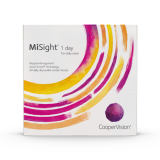Introducing new MiSight® Spectacle Lenses powered by Diffusion Optics Technology™
MiSight® Spectacle Lenses with Diffusion Optics Technology™ is a new and unique lens technology which reduces contrast to help slow axial elongation in myopia.2
The efficacy and safety of MiSight® Spectacle Lenses in reducing progression of childhood myopia has been tested in CYPRESS, a randomized, controlled, double-masked, multi-site, parallel group clinical trial (256 children aged 6-10, many ethnicities).1
And 4 in 10 children showed no clinically meaningful progression in refractive error1‡
MiSight® Spectacle Lenses were particularly effective in the youngest patients, aged 6-7 years old, who have the fastest progression, where no other spectacles have been evaluated for effectiveness.1
Children readily adapt to Diffusion Optics Technology™1
Average wearing time for both MiSight® Spectacle Lenses and regular spectacles was more than 12 hours each day over 2 years1∞
More than 3/4 children love their MiSight® Spectacle Lenses¥ and most think they make them look cool≠
MiSight® Spectacle Lenses are designed to fit seamlessly into your practice
MiSight® Spectacle Lenses are prescribed like many other single-vision spectacle lenses.1^
No extra chair time
Easy to fit
MiSight® Spectacle Lenses Indications: MiSight spectacle lenses are indicated for the correction of refractive ametropia (myopia and/or astigmatism) and for the reduction in the rate of myopic progression in phakic children who are aged 6 to 13 years old with non-diseased eyes. Please refer to Instructions for Use (IFU) for information on product description, materials, parameters, indications, contraindications, warnings, and potential complications.
*Compared to control spectacle lenses over 24 months. Analysis based on parent responses to in-office question, “Does your child remove their spectacles for any near vision activities?” (n=51 test, n=62 control). For the full study cohort, reduction in progression of spherical equivalent refraction and axial length from baseline over 24 months was 47% and 24% on average respectively.
†MiSight® Spectacle Lenses are indicated in Canada for the correction of refractive ametropia (myopia and/or astigmatism) and for the reduction in the rate of myopic progression in phakic children who are aged 6 to 13 years old with non-diseased eyes. Please refer to Instructions for Use (IFU) for information on product description, materials, parameters, indications, contraindications, warnings, and potential complications.
‡No clinically meaningful change in refractive error means that there was less than a 0.25D increase in myopia from baseline as measured by cycloplegic autorefraction (p<0.0001).
∞ MiSight Spectacle Lenses are indicated to be worn constantly for all activities except for those outlined in WARNINGS (a minimum of 10 hours per day).
¥ Proportion agreeing to “I love my glasses” at the 30-day, 6-month, 12-month, 18-month, and 24-month visits.
≠ Proportion agreeing to “My glasses make me look cool” at the 30-day, 6-month, 12-month, 18-month, and 24-month visits.
^ Pupil center height measurements required.
SGV data on file 2021. Control of Myopia Using Peripheral Diffusion Lenses: Efficacy and Safety Study, 24-month results (n = 256, 14 North American sites).
Rappon J, et al. CYPRESS 12-month Results: Safety and Efficacy from a Pivotal Study of Novel Spectacle Lenses Designed to Reduce Myopia Progression. Optometry and Vision Science. 2020;97:E-abstract 200036
Rappon J, et al. Novel DOT Lenses from SightGlass Vision Show Great Promise to Fight Myopia. Review of Myopia Management. Available at: http://reviewofmm. com/novel-dot-lenses-from-sightglass-vision-show-great-promise-to-fight-myopia/ [Accessed Sep 2021];
Rappon J, et al. Tolerability of novel myopia control spectacle designs. Investigative Ophthalmology & Visual Science. 2019;60(9):5845-5845;





